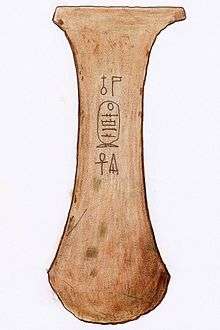Semenre
Semenre, also Smenre[1] or Semenenre,[3] is a poorly attested Theban pharaoh during the Second Intermediate Period of Egypt who succeeded the equally obscure Nebiriau II.[3][4] He reigned from 1601 to 1600 BC (Kim Ryholt)[4] or ca. 1580 BC (Detlef Franke) and belonged to the 16th Dynasty (Ryholt)[4] or the 17th Dynasty[1] (Franke).
| Semenre | ||||||||||||||||||||||||||
|---|---|---|---|---|---|---|---|---|---|---|---|---|---|---|---|---|---|---|---|---|---|---|---|---|---|---|
| Smenre, Semenenre | ||||||||||||||||||||||||||
 Axehead with the name of Semenre, Petrie Museum UC30079[1] | ||||||||||||||||||||||||||
| Ruler of Upper Egypt | ||||||||||||||||||||||||||
| Reign | ca. 1600 BC or 1580 BC (16th Dynasty or 17th Dynasty) | |||||||||||||||||||||||||
| Predecessor | Nebiriau II | |||||||||||||||||||||||||
| Successor | Bebiankh | |||||||||||||||||||||||||
| ||||||||||||||||||||||||||
For this ruler only the throne name is known, carved on a tin-bronze axe head of unknown provenance, now in the Petrie Museum, London (UC30079). He is possibly also listed on the Turin Canon (11.7).[1]
Semenre was succeeded by Seuserenre Bebiankh[3][4] who left behind more traces of building projects and mining activity in his reign than most kings of this dynasty with the exception of Djehuti.[5]
References
- Davies, V.W. (1981). "Two inscribed objects from the Petrie Museum". Journal of Egyptian Archaeology. 67: 175–178.
- Ryholt 1997, p. 450
- von Beckerath 1984, pp. 126-27
- Ryholt 1997, p. 202
- Darrell D. Baker: The Encyclopedia of the Egyptian Pharaohs, Volume I: Predynastic to the Twentieth Dynasty (3300-1069 BC), Bannerstone Press, London 2008, ISBN 978-1-905299-37-9, p. 375.
- Ryholt, Kim (1997). The Political Situation in Egypt During the Second Intermediate Period, C. 1800-1550 B.C. Copenhagen: Museum Tusculanum Press.
- von Beckerath, Jürgen (1984). Handbuch der ägyptischen Königsnamen. München-Berlin: Deutscher Kunstverlag. ISBN 3422008322.
| Preceded by Nebiriau II |
Pharaoh of Egypt Sixteenth Dynasty of Egypt |
Succeeded by Bebiankh |
This article is issued from Wikipedia. The text is licensed under Creative Commons - Attribution - Sharealike. Additional terms may apply for the media files.